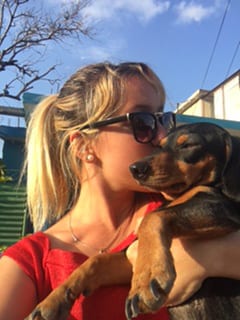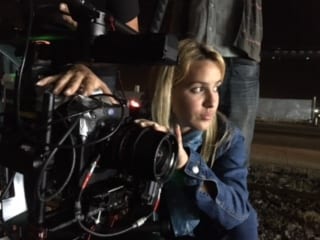Eleven Minutes of Horror: Stray Animals in Cuba
Veronica Vega

HAVANA TIMES — “Natural Selection” is a documentary which shows, in only eleven minutes and a succession of visual cuts, the current landscape for stray animals in Cuba.
Filmed in May 2016, it was officially shown on April 7th this year at the Cine Chaplin, during Havana’s Young Filmmakers’ Festival, where it received a side prize: the creativity grant awarded by the Ludwig Foundation in Cuba.
“Natural Selection” has traveled the world in the year that it was absent from Cuban screens. It was presented at the Ethnografilm Festival in Paris, at the LA CineFest (Los Angeles) where it was a semi-finalist, at America’s Rainbow Film Festival, in New York, at the Indie Wise Free Virtual Festival…
The film’s director, Cynthia Cazanas Garin is a fourth year student at the Facultad Arte de los Medios de Comunicación Audiovisual (FAMCA), where she specializes in Direction of Photography for films and TV. At just 21 years old and with a radiant face, she states that her target audience has always been the Cuban audience.
I don’t know what we’re turning into
HT: What motivated you to make this documentary?
Cynthia Cazanas Garin: My dad is an animal protector, and it was through him that I began to learn a little about this subject: that there is a dog catching program, what the situation is with stray animals, the need to create an Animal Protection Law… And when I began to research what the current landscape is here in Cuba, that’s what made me decide to make this documentary, and I did it with the objective to help in some way.
HT: How long did it take you to gather all the information that appears in the documentary?
CCG: About three months. Filming as such only took a month and then, of course, there’s the time you need for post-production, but the most difficult thing was getting film permits to shoot at the Dog Catcher’s and at the Public Health Ministry.
 HT: Was that the greatest challenge?
HT: Was that the greatest challenge?
CCG: Yes, coming up with a strategy that would allow me to bring my camera into a place such as the Dog Catcher’s, where filming is strictly forbidden, to get an interview with one of its managers… always with a letter from my school, which allowed me to prove that it was an educational project.
I came to think that I wouldn’t be able to pull it off, but my parents and my grandmother supported me so much, with funding the project and also emotionally. Another of the bigger challenges I faced was working with such little technical equipment; there was only one guy who helped me film the shots on the street and with editing, but most of it was directed by me: editing, photography, production, sound… everything. The greatest risk I had was that it wouldn’t be the documentary I wanted to make, that it would be something else, because I dared to choose a very difficult subject matter for my final exam and I didn’t have a lot of time. I could have even failed the year.
I also received a lot of support from my professors. The Dean in my Faculty was always advising me, asking if I was clear about what I wanted because it’s a subject which isn’t seen in Cuban film, and that’s what made my documentary even more necessary. If you do a survey with people on the street right now, many don’t know what the Dog Catcher is; there are even a lot of myths.
HT: One of these myths is that the dogs they catch are thrown to the lions at the Zoo.
CCG: Yes, people constantly say this and that’s because there isn’t any infomration, and that was one of the things that helped me convince them.
HT: Is it true that strychnine injections cause animals to convulse for 45 minutes?
CCG: The person I interviewed didn’t explain anything about this, the only thing he said was: strychnine. Just like you see in the documentary, they have very few resources and I think that the government should support them, finding a way for animals to die in the least painful way possible, which would be euthanasia, according to Animal Wellbeing laws. Even though the solution isn’t to kill them, but to sterilize them, to create mass campaigns and especially an Animal Protection Law, because there are things outside of the Dog Catcher’s control such as dog fighting, for example. This law has to be created and a different conscience needs to be promoted when it comes to animals, creating a culture of responsible ownership.
 HT: Now that you mention dog fighting, there’s a fight which appears in the documentary and it’s one of the most violent scenes, did you take it from another documentary?
HT: Now that you mention dog fighting, there’s a fight which appears in the documentary and it’s one of the most violent scenes, did you take it from another documentary?
CCG: Yes, from the short film “Por amor”, which isn’t very well-known. The girl who made it has left Cuba now, it wasn’t even shown, and it’s almost unedited. The title is ironic, from the dog’s point of view, it’s his loyalty, how he is able to die for his owner. The director gave me the rights to use this scene because it’s very difficult to attend a dog fight, as it is an illegal activity to some point. And I say “to some point” because there is no law in Cuba which stops you from fighting your dog, and that’s one of the things we are strugling for. What you can’t do is bet.
HT: Why the title “Natural Selection”?
CCG: The title refers to Charles Darwin’s theory, but you can look at it from two angles: from the animals’ point of view, their everyday struggle to survive, and also from people’s points of view. As people are becoming more and more insensitive, ignoring animal rights, not thinking that they are living beings and how their attitude has contributed to creating an uncivilized society. According to Darwin’s theory, natural selections is a form of evolution but from the point of view of civilization, it is rather a regression.
HT: How did you hope it would be received?
CCG: I always knew, and my professors always warned me: that my documentary was going to be very shocking, because it’s a very complex issue and because of the way I have dealt with it. I decided to put in the scenes of cruelty because they were necessary, and I always hoped that people would take it this way because this is reality. I wanted it to reach them, to really move them. I have seen people who haven’t wanted to continue watching, who cry, who leave the cinema… a lot of times, but I don’t need to change these people’s mentality. I need those who stay in the cinema, those who feel nothing for animals, who don’t like them, who have never even thought about the significance that abuse they have suffered has, while they can suffer. That was always my hope.
HT: Where has it been screened the most?
CCG: After being shown at the Chaplin, it was screened at the Academia Dante Alighieri, where a conference about Cuban and Italian animals was held, which had been organized by members of the Veterinary Science Council, and it was the subject of their debate. According to what I’ve been told, it’s also been shown at the Veterinary School. And I think that’s great, because it’s important that young people who are studying to become veterinarians know what is happening, that they aren’t fooled. That they know jsut how important their job is when it comes to animals’ wellbeing.
 HT: Why did it take a year for it to be officially shown in Cuba?
HT: Why did it take a year for it to be officially shown in Cuba?
CCG: I don’t know. They never told me that it was censored, I was even interviewed for national TV but the interview never came out, they never put the documentary on either. I sent it to the Havana Film Festival and they told me that they had too many projects. Thanks to the Young Filmmaker’s Festival, it was finally able to be shown in Cuba.
HT: Why did you choose to study film?
CCG: In my opinion, film is what unites all the art forms and my connection with it is very strong. It allows you to express your inner thoughts, your subjectivity. It allows you to dream, to fly… But it is also a very powerful weapon which transmits and controls information. And I believe that it can be used for the good of society, of human beings and living beings in general.
HT: So you believe that it being one of the most popular mediums, can contribute to the regeneration of society?
CCG: It can always contribute, in a positive or negative manner. In my case, I want to use my knowledge to change people’s mentalities towards a new society where human values are restored. I believe that this is my duty with film. To fight for the dreams which still haven’t been made reality.
HT: “Natural Selection” is very hard-hitting, but it ends with a glimpse of hope. Is this just a film technique or do you really believe this hope exists?
CCG: I wanted it to be a blow to those who are responsible for making this hope a reality, let’s say the government, I wanted them to see it and ask themselves, what is this? What kind of society are we building? Everything that is depicted in this documentary is wrong, something which needs to be urgently changed. Hope doesn’t really lie in the documentary; it lies in the viewer, when they finish watching it.
 HT: Do you think passing an Animal Protection Law in Cuba is viable?
HT: Do you think passing an Animal Protection Law in Cuba is viable?
CCG: Viable? I don’t know. All I know is that it’s crucial. But, three draft bills have been made and they haven’t led to anything, why? And these haven’t been proposals that the Cuban people have suggested, but they have rather come from experts who have studied this phenomenon, who have presented the facts. What else does the government need? I hope that this Law will be approved at some point; it’s what I most want.
HT: Do you know a lot of young people who are concerned about the animal situation in Cuba?
CCG: No. I think there are very few people who are concerned about this, and not only this, but about Nature on the whole. There isn’t a lot of culture here of looking after the environment, I believe we need to work more on this, educate… everything starts with education. If you walk down the street, you’ll see that the first people to throw some trash onto the ground or abuse an animal are adults, and next to them you see children, young people. This behavior is then reflected in their own lives. I can’t say that there isn’t anybody who worries about this, at my school, for example, I see some people but, how many? 3, 4, 5? What are 4 or 5 people when we are millions? This really distresses me because I don’t know where this will end. I don’t know what we’re turning into.
HT: Do you believe that Cuban youth worry about the future of our country?
CCG: I don’t believe they are that interested. I wish they were! There are a lot of university projects which are led by professors, and I would like these to be led by the students themselves. That students themselves come together and say: “Let’s make an eco-friendly group”, or “Let’s create an animal protection project”, but this interest, when it exists, I don’t find it among young people. I know a group of ecologists made up of young people and I am very happy to know they exist because they are an example of the few people who worry about this, if only more people would join, but they don’t receive any support either, they don’t have the means to promote their work. I believe that every individual can contribute in their own way, with what they know.
HT: What do you see young people interested in?
CCG: I think they live the day to day, the present. That’s what I see: that they are a little unmotivated. They study and then they work in something else, they don’t follow what they want, they don’t follow their dreams, and although we have all the problems we have in society, you can never lose the motivation to live, you have to fight for what you want. What you want won’t turn up and knock on your door to say: “I’m here,” you have to go out and look for what you want. What’s the worst that will happen, that you don’t get it? At least you tried, and you also enjoy that experience. I tried to make this documentary a lot of times, that is to say, to get the permits I needed. However, all the doors closed in my face but I kept on trying, until I managed to get what it was that I wanted. You can never try hard enough.
HT: What are your future plans?
CCG: To use this creativity grant from the Ludwig Foundation to make a new documentary that will also be about animals because there were a lot of things that I couldn’t include in this one. I have also thought about doing something related to animation photography, for my thesis. My future plans are somewhat overaching… I want to continue to do what I’m doing, to continue making films that benefit people, to change what I feel needs to change.

I just came back from visit to Cuba- was not prepared for what I saw. It was pure torture for me until my flight home. What can be done? I’m grief stricken because nobody seems to care- not even the people on my tour.
Sadly, there are scores of beautiful young people in Cuba who, like Cynthia it would appear, seem to unlimited potential. Then, unfortunately, something happens to them. The Castro regime seems to suck the very life out of them. The Dictatorship, from Camilo Cienfuegos and on, will accommodate no other stars in their universe. If you don’t agree with the rulers, you don’t exist. At least not for long….
When at home in Cuba at night, I hear the pitiful howls and whining of the dogs with oddly starting at about midnight, the crowing of the cockerels. Another sound which occurs predominantly in the evenings is the squealing and grunting of pigs with even the occasional whinny from a horse. I see dogs tied on short ropes exposed to the elements with only an oil drum with both ends cut out as protection from the hot sun and torrential rain.
Cuba inherited the centuries old culture of Spain and of a combination of indifference and cruelty to animals to be found in Spain even today. Bull fighting, cock fighting, dog fighting, indifference to the suffering of horses are long established “cultural” characteristics of the Iberian peninsula.
It is wonderful that a young Cuban managed to overcome all the impediments and obstacles which were placed in her path and utter up her plea for change in Cuba, hers is a tale of persistence. We can only hope that Cynthia has initiated a movement among younger Cubans for the pursuit of animal rights.
The indifference about which she speaks reflects an educational system which is based upon establishing conformity and discouraging individuality – Cynthia is an exception. She is right about the indifference to dumping rubbish so evident in the towns and cities and on an astonishingly large scale in areas like the shoreline of Saludo and Baracoa west of Havana.
In speaking of her hope that human values can be restored in Cuba, Cynthia is endeavoring to change the lazy, ill-managed, incompetent administrations at national, provincial and municipal levels which have developed under the current administration which is unlikely to change and implement new policies having failed to address the evident needs so dismally for so many years.
I and thousands of others – irrespective of political viewpoints will hope that Cynthia has started a movement and that Cubans will adopt a more enlightened and considerate attitude towards animals and the environment – especially the urban one.
I happened to be lucky enough to meet Cynthia on a recent trip to Cuba and to view the video laying on her bed holding her dog Bobby. This is a remarkable, ambitious, intelligent, beautiful, idealistic woman who thinks far more about how to improve situations outside of herself then she does her own fate. I could have talked with her for months and never found a subject she couldn’t speak on smartly, articulately and at length. Her passion was invigorating and I find myself still talking about her half a year later. Also, man you should hear her sing! She is one of the most interesting people I have ever met and I’m excited to see where she goes from here. The animal situation in Cuba is heartbreaking and I am exceedingly glad they have Cynthia on their side!